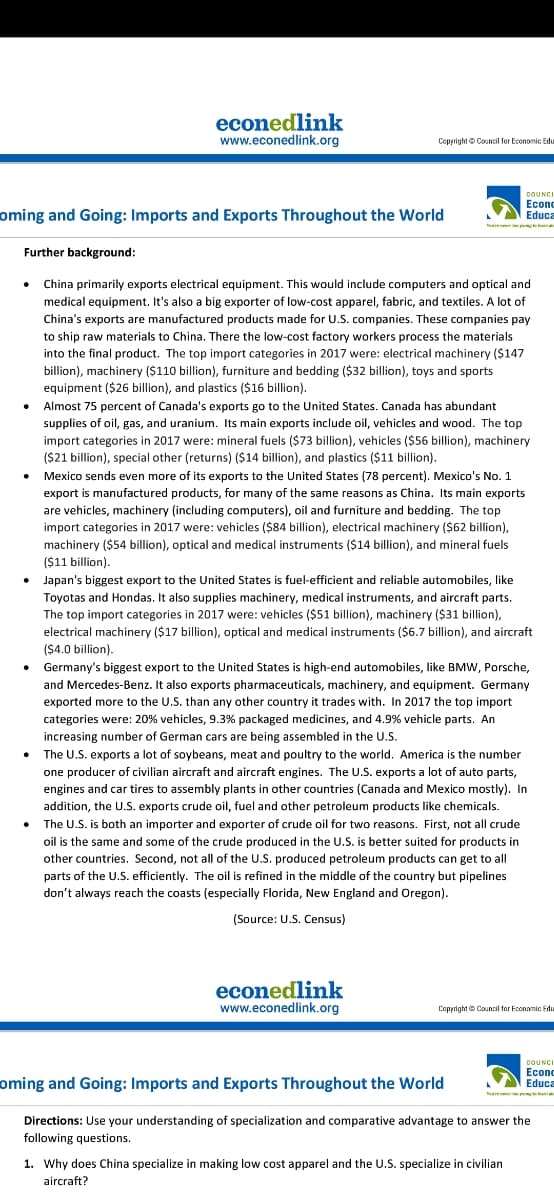Notice that there is little mention of the U.S. importing food or agriculture. What does that say about America’s farmers? 5. Why do so many of Mexico’s and Canada’s exports go to the U.S? What problems could that create for their economies?
Notice that there is little mention of the U.S. importing food or agriculture. What does that say about America’s farmers? 5. Why do so many of Mexico’s and Canada’s exports go to the U.S? What problems could that create for their economies?
Principles of Macroeconomics (MindTap Course List)
8th Edition
ISBN:9781305971509
Author:N. Gregory Mankiw
Publisher:N. Gregory Mankiw
Chapter9: Application: International Trade
Section: Chapter Questions
Problem 1CQQ
Related questions
Question
100%
4. Notice that there is little mention of the U.S. importing food or agriculture. What does that say about America’s farmers?
5. Why do so many of Mexico’s and Canada’s exports go to the U.S? What problems could that create for their economies?

Transcribed Image Text:econedlink
www.econedlink.org
Coppright Council for Economic Edu
COUNCI
Econc
Educa
oming and Going: Imports and Exports Throughout the World
N pna
Further background:
China primarily exports electrical equipment. This would include computers and optical and
medical equipment. It's also a big exporter of low-cost apparel, fabric, and textiles. A lot of
China's exports are manufactured products made for U.S. companies. These companies pay
to ship raw materials to China. There the low-cost factory workers process the materials
into the final product. The top import categories in 2017 were: electrical machinery ($147
billion), machinery ($110 billion), furniture and bedding ($32 billion), toys and sports
equipment ($26 billion), and plastics ($16 billion).
Almost 75 percent of Canada's exports go to the United States. Canada has abundant
supplies of oil, gas, and uranium. Its main exports include oil, vehicles and wood. The top
import categories in 2017 were: mineral fuels ($73 billion), vehicles ($56 billion), machinery
($21 billion), special other (returns) ($14 billion), and plastics ($11 billion).
Mexico sends even more of its exports to the United States (78 percent). Mexico's No. 1
export is manufactured products, for many of the same reasons as China. Its main exports
are vehicles, machinery (including computers), oil and furniture and bedding. The top
import categories in 2017 were: vehicles ($84 billion), electrical machinery ($62 billion),
machinery ($54 billion), optical and medical instruments ($14 billion), and mineral fuels
($11 billion).
Japan's biggest export to the United States is fuel-efficient and reliable automobiles, like
Toyotas and Hondas. It also supplies machinery, medical instruments, and aircraft parts.
The top import categories in 2017 were: vehicles ($51 billion), machinery ($31 billion),
electrical machinery ($17 billion), optical and medical instruments ($6.7 billion), and aircraft
($4.0 billion).
Germany's biggest export to the United States is high-end automobiles, like BMW, Porsche,
and Mercedes-Benz. It also exports pharmaceuticals, machinery, and equipment. Germany
exported more to the U.S. than any other country it trades with. In 2017 the top import
categories were: 20% vehicles, 9.3% packaged medicines, and 4.9% vehicle parts. An
increasing number of German cars are being assembled in the U.S.
The U.S. exports a lot of soybeans, meat and poultry to the world. America is the number
one producer of civilian aircraft and aircraft engines. The U.S. exports a lot of auto parts,
engines and car tires to assembly plants in other countries (Canada and Mexico mostly). In
addition, the U.S. exports crude oil, fuel and other petroleum products like chemicals.
• The U.S. is both an importer and exporter of crude oil for two reasons. First, not all crude
oil is the same and some of the crude produced in the U.S. is better suited for products in
other countries. Second, not all of the U.S. produced petroleum products can get to all
parts of the U.S. efficiently. The oil is refined in the middle of the country but pipelines
don't always reach the coasts (especially Florida, New England and Oregon).
(Source: U.S. Census)
econedlink
www.econedlink.org
Copyright Council for Econamic Fdu
COUNCI
oming and Going: Imports and Exports Throughout the World
Есon
Educa
Nee
Directions: Use your understanding of specialization and comparative advantage to answer the
following questions.
1. Why does China specialize in making low cost apparel and the U.S. specialize in civilian
aircraft?
Expert Solution
This question has been solved!
Explore an expertly crafted, step-by-step solution for a thorough understanding of key concepts.
This is a popular solution!
Trending now
This is a popular solution!
Step by step
Solved in 2 steps

Knowledge Booster
Learn more about
Need a deep-dive on the concept behind this application? Look no further. Learn more about this topic, economics and related others by exploring similar questions and additional content below.Recommended textbooks for you

Principles of Macroeconomics (MindTap Course List)
Economics
ISBN:
9781305971509
Author:
N. Gregory Mankiw
Publisher:
Cengage Learning

Brief Principles of Macroeconomics (MindTap Cours…
Economics
ISBN:
9781337091985
Author:
N. Gregory Mankiw
Publisher:
Cengage Learning

Principles of Macroeconomics (MindTap Course List)
Economics
ISBN:
9781305971509
Author:
N. Gregory Mankiw
Publisher:
Cengage Learning

Brief Principles of Macroeconomics (MindTap Cours…
Economics
ISBN:
9781337091985
Author:
N. Gregory Mankiw
Publisher:
Cengage Learning